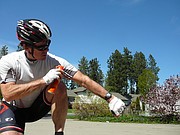Invisible armor
By JERRY HITCHCOCK
Staff Writer
Nothing can spoil a great day on the outdoors quicker than suffering through hours of stinging insect bites. Many people will see and feel the area around the bites well up, and itching can last for days afterward.
If you’ve been so afflicted. you either made the decision to forgo repellent altogether, or you applied some, but it became ineffective at some point.
We are in the midst of a bad season for mosquitoes in North Idaho. The harsh winter’s snowmelt and spring rains have led to an abundance of standing water, allowing the pesky little critters to assemble and lay waste to exposed skin in wholesale fashion.
Much has been printed in the media over the last decade about the hazards of DEET, the active chemical most often used in the making of insect repellents.
Currently, the EPA lists DEET as slightly toxic to birds, fish and aquatic invertebrates, with almost no toxicity to mammals. The organization rates DEET as Toxicity Category III, the second lowest of its four categories — or “slightly toxic.”
Another chemical, precaridin, is considered more affective against flies than DEET. There are also two synthesized, plant oil options — Lemon/eucalpytus oil and IR3535. Both are effective for less time than DEET and precaridin (8-10 hours). The plant oils can work 4-6 hours, depending on several factors. Nonsynthesized plant oils (soybean, lemongrass, cedar and citronella) can work between 30 minutes to two hours, depending on application.
For longest protection, see product labels for time estimates. If you prefer to keep it natural, you’ll need to reapply often.
Some clothing now comes with insect repellent. A compound called Insect Shield is available and while not readily available at the present time, apparel with this built-in protection may become commonplace.
Care must be taken when choosing to use a product to be used on the young ones.
An advisement from the American Academy of Pediatrics prohibits using repellent on infants younger than 2 months. If parents choose to use a DEET repellent, concentrations should be no greater than 30 percent. All repellents could cause skin irritation for children with sensitive skin. If this happens, try a different formula. Kids find sprays more fun to apply, but lotions can be milder on their skin.
I often find myself needing both sunscreen and insect repellent when I’m out in the local forested areas. Going in and out of the canopy for hours on end can lead to a nasty burn if you don’t apply something to ward off the sun’s burning rays.
For years, I’ve tried various combinations of sunscreen and repellent, with varying degrees of success. I’ve put the sunscreen on first, then the repellent, and the other way around. I always tried to think which one I’d need to reapply first, and then I’d apply that last, so the two coats contact each other.
Now after doing research, the Centers for Disease Control and Prevention advises you apply your sunscreen first, then the repellent.
Although you may need to reapply sunscreen up to every two hours (depending on what SPF you decide to use) the CDC still wants the initial sunscreen contacting the skin.
This makes sense, because you want the repellent on the outside, so mosquitoes and ticks come in direct contact with it and scurry away.
While I’ve never found a sunscreen or repellent that is fun to apply, smell or remove, the benefits of use far outweigh the consequences of a day in the outdoors without.
- A note on Fido
I wanted to add that you should never use insect repellents made for humans on dogs. There are several products made specifically for our four-legged friends, and I’ve seen some two-oil recipes online that are said to be effective. Ticks can prove to be more bothersome than mosquitoes, especially for dogs with a thin coat of hair.
- • •
Jerry Hitchcock can be reached at 664-8176, Ext. 2017, via email at jhitchcock@cdapress.com, or follow him on Twitter at HitchTheWriter.



